Herodotus on Sesostris' Reliefs
Sesostris' Reliefs: two reliefs, presented by Herodotus as evidence that a great Egyptian king once conquered almost the whole world.
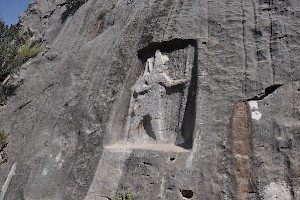
In the second book of his Histories, the Greek researcher Herodotus presents a king Sesostris, who, prior to Cyrus and Darius, conquered almost the whole globe. To prove that he really existed, Herodotus mentions two reliefs in Egyptian style that he has seen at Karabel (Turkey) and the Nahr al-Kalb (Lebanon).
There have indeed been several pharaohs with the name of Sesostris, or, to use the Egyptian form of this name: Senusret. The third of these, whose reign is dated to 1862-1844, was a great conqueror indeed, although Herodotus' claims are quite exaggerated.
The monument at the Nahr al-Kalb, just north of modern Beirut, is easy to identify and can still be visited. There used to be three monuments in Egyptian style, which commemorated several campaigns by a later pharaoh, Ramesses II (r.1279-1213). Two of them, badly damaged, have survived, and have inspired just about every later conqueror to leave a relief as well.
The other relief, along the road from Sardes to Smyrna, in fact represents king Tarkasnawa of the Hittite vassal kingdom Mira, and can be seen in the pass of Karabel. Unfortunately, it is not easy to find. If you take the modern road from Selçuk to Kemalpasa, you will cross the Nif Dagi (a mountain range) at Karabel. At the top of this mountain pass, to your left when you arrive from the south, is the entrance of a forest park. The rock itself is 2200 meters (check the odometer of your car) farther north, where the road is already going downwards. In a curve to the left, on the right hand side, is a small concrete staircase, which leads to a stony path that will bring you to the Karabel relief.
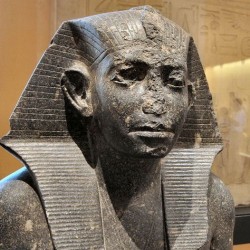 Senusret III |
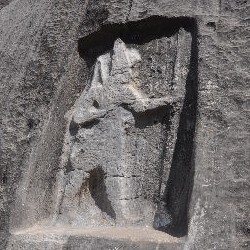 Karabel Pass, Rock relief of king Tarkasnawa of Mira |
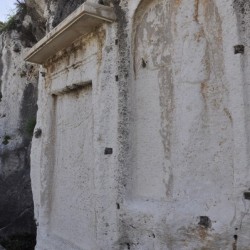 Nahr al-Kalb, Reliefs of Ramesses II (left) and Esarhaddon |
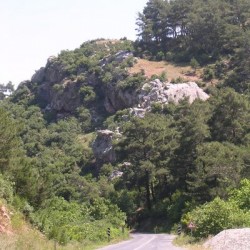 Karabel Pass, with rock relief seen from the south |
[2.102] I shall make mention of the king who came after these, whose name was Sesostris. He first of all set out with ships of war from the Arabian gulf and subdued those who dwelt by the shores of the Erythraean Sea, until as he sailed he came to a sea which could no further be navigated by reason of shoals. Then secondly, after he had returned to Egypt [...] he took a great army and marched over the continent, subduing every nation which stood in his way. Those of them whom he found valiant and fighting desperately for their freedom, in their lands he set up pillars which told by inscriptions his own name and the name of his country, and how he had subdued them by his power; but as to those of whose cities he obtained possession without fighting or with ease, on their pillars he inscribed words after the same tenor as he did for the nations which had shown themselves courageous, and in addition he drew upon them the hidden parts of a woman, desiring to signify by this that the people were cowards and effeminate.note
[2.103] Thus doing he traversed the continent, until at last he passed over to Europe from Asia and subdued the Scythians and also the Thracians. These, I am of opinion, were the furthest people to which the Egyptian army came, for in their country the pillars are found to have been set up, but in the land beyond this they are no longer found. [....]
[2.106] The pillars which Sesostris of Egypt set up in the various countries are for the most part no longer to be seen extant; but in Syria Palestine I myself saw them existing with the inscription upon them which I have mentioned and the emblem. Moreover in Ionia there are two figures of this man carved upon rocks, one on the road by which one goes from the land of Ephesus to Phocaea, and the other on the road from Sardes to Smyrna. In each place there is a figure of a man cut in the rock, of four cubits and a span in height, holding in his right hand a spear and in his left a bow and arrows, and the other equipment which he has is similar to this, for it is both Egyptian and Ethiopian: and from the one shoulder to the other across the breast runs an inscription carved in sacred Egyptian characters, saying thus, "This land with my shoulders I won for myself."